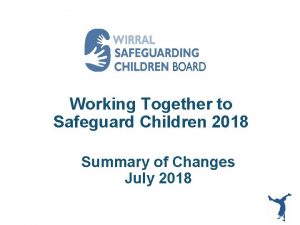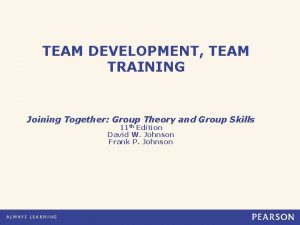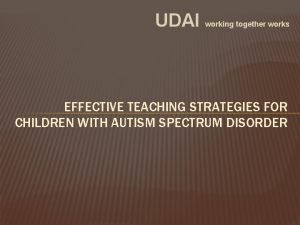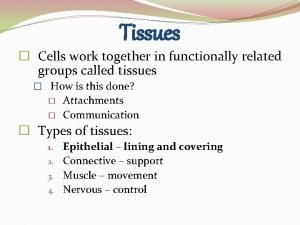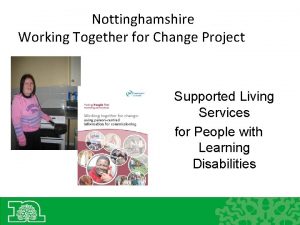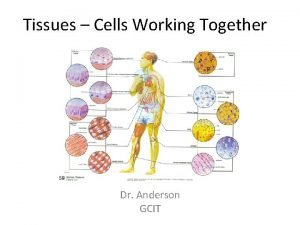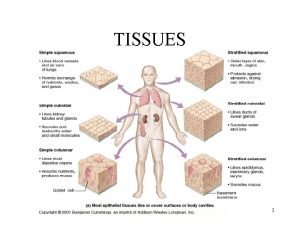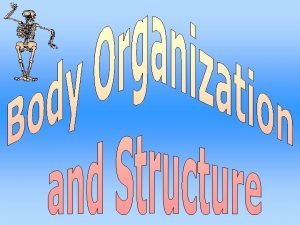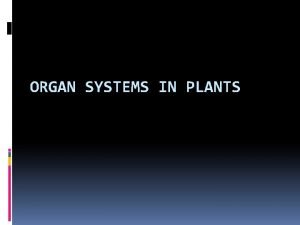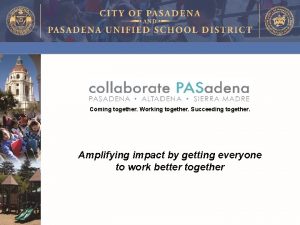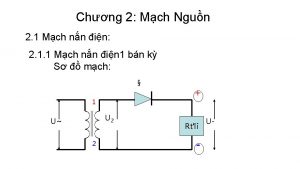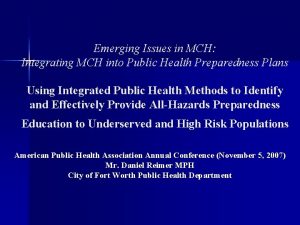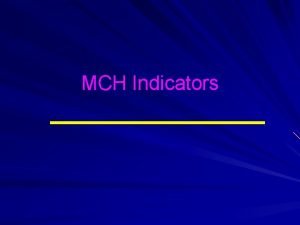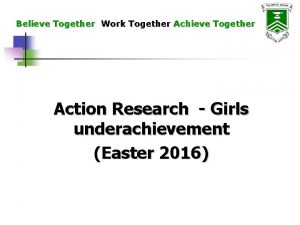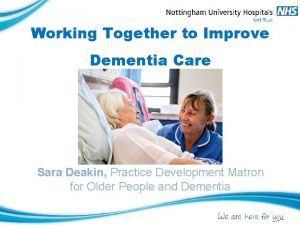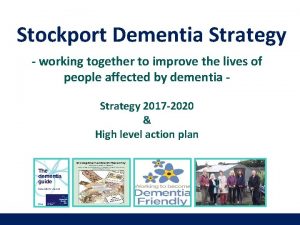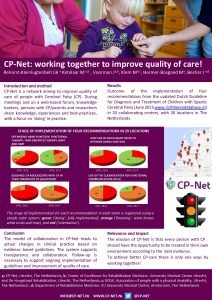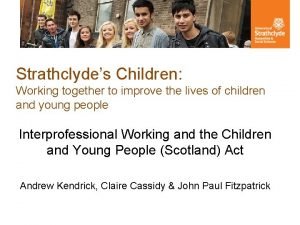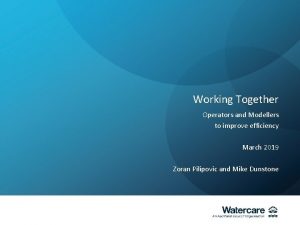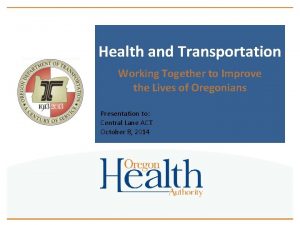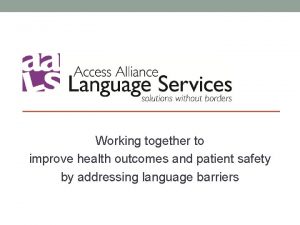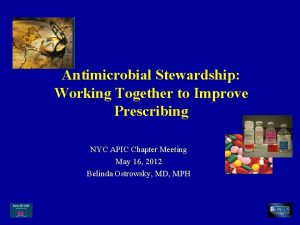MCH 2016 2020 Working Together to Improve MCH























- Slides: 23

MCH 2016 -2020: Working Together to Improve MCH in Colorado Karen Trierweiler, MS, CNM MCH Director & Deputy Director Prevention Services Division 2/29/16 This project was supported by the Health Resources and Services Administration (HRSA) of the U. S. Department of Health and Human Services (HHS) under grant number B 04 MC 28087, Maternal and Child Health Services. This information or content and conclusions are those of the author and should not be construed as the official position or policy of, nor should any endorsements be inferred by HRSA, HHS or the U. S. Government. 1

Our Goals Today Why Do We Do What We Do? Review MCH outcomes from 2011 -2015 Highlight changes in federal MCHB expectations (“MCH 3. 0”) Highlight Colorado’s 2016 -2020 MCH Priorities Introduce the concept of Implementation Science and Performance Management – “MCH Impact” This project was supported by the Health Resources and Services Administration (HRSA) of the U. S. Department of Health and Human Services (HHS) under grant number B 04 MC 28087, Maternal and Child Health Services. This information or content and conclusions are those of the author and should not be construed as the official position or policy of, nor should any endorsements be inferred by HRSA, HHS or the U. S. Government. 2

Why Do We Do This Work? We envision a future where all women, children, youth and families are healthy and thriving. The health and well-being of women, children, youth and families is the key to our future as a state and a nation. MCH is the protector and guarantor of health and well-being for children and youth with special health care needs This project was supported by the Health Resources and Services Administration (HRSA) of the U. S. Department of Health and Human Services (HHS) under grant number B 04 MC 28087, Maternal and Child Health Services. This information or content and conclusions are those of the author and should not be construed as the official position or policy of, nor should any endorsements be inferred by HRSA, HHS or the U. S. Government. 3

Our Ultimate Goal To optimize the health and well-being of the MCH population throughout the life course – to improve people’s lives This project was supported by the Health Resources and Services Administration (HRSA) of the U. S. Department of Health and Human Services (HHS) under grant number B 04 MC 28087, Maternal and Child Health Services. This information or content and conclusions are those of the author and should not be construed as the official position or policy of, nor should any endorsements be inferred by HRSA, HHS or the U. S. Government. 4

How Do We Do This Work? Health Impact Pyramid Narrower Increasing individual effort needed Telling patients to eat healthy and be physically active Counseling & Education Rx for cardiovascular disease Clinical interventions Immunizations, cessation treatment, colonoscopy Long lasting protective interventions Fluoridation, trans fat bans, smoke free laws Changing the context to make individual’s default decisions healthy Addressing poverty, lack of education, poor housing, lack of transportation access, inequality Socioeconomic factors SOURCE: A Framework for Public Health Action: The Health Impact Pyramid Thomas R. Frieden. Am J Public Health. 2010 April; 100(4): 590– 595. doi: 10. 2105/AJPH. 2009. 185652 PMCID: PMC 2836340 Increasing population impact Broader This project was supported by the Health Resources and Services Administration (HRSA) of the U. S. Department of Health and Human Services (HHS) under grant number B 04 MC 28087, Maternal and Child Health Services. This information or content and conclusions are those of the author and should not be construed as the official position or policy of, nor should any endorsements be inferred by HRSA, HHS or the U. S. Government. 5

How Do We Do This Work? Factors Influencing Health Status Biology 20% Lifestyle 51% Smoking Obesity Nutrition Alcohol Use Health Care 10% Environment 19% This project was supported by the Health Resources and Services Administration (HRSA) of the U. S. Department of Health and Human Services (HHS) under grant number B 04 MC 28087, Maternal and Child Health Services. This information or content and conclusions are those of the author and should not be construed as the official position or policy of, nor should any endorsements be inferred by HRSA, HHS or the U. S. Government. 6

How Do We Do This Work? We focus… our work on primary prevention and early intervention. on identifying and implementing evidence-based or evidence-informed strategies for impact. on implementing complementary state & local strategies and monitoring their success to improve MCH. This project was supported by the Health Resources and Services Administration (HRSA) of the U. S. Department of Health and Human Services (HHS) under grant number B 04 MC 28087, Maternal and Child Health Services. This information or content and conclusions are those of the author and should not be construed as the official position or policy of, nor should any endorsements be inferred by HRSA, HHS or the U. S. Government. 7

2010 - 2015 This project was supported by the Health Resources and Services Administration (HRSA) of the U. S. Department of Health and Human Services (HHS) under grant number B 04 MC 28087, Maternal and Child Health Services. This information or content and conclusions are those of the author and should not be construed as the official position or policy of, nor should any endorsements be inferred by HRSA, HHS or the U. S. Government. 8

How Did We Do in 2011– 2015? Statewide quantitative improvements noted for: ü Pregnancy-Related Depression ü Developmental Screening ü Early Childhood Obesity Prevention ü Teen Fertility This project was supported by the Health Resources and Services Administration (HRSA) of the U. S. Department of Health and Human Services (HHS) under grant number B 04 MC 28087, Maternal and Child Health Services. This information or content and conclusions are those of the author and should not be construed as the official position or policy of, nor should any endorsements be inferred by HRSA, HHS or the U. S. Government. 9

Qualitative Observations - State Successful progress associated with: Implementation of well conceived state level strategies Deliberate adherence to state level action plan/timeline with real -time course corrections Cohesive, functional advisory groups and partnerships Garnering of add’l resources/$$ based on forward progress State staff skill in population health and implementation science This project was supported by the Health Resources and Services Administration (HRSA) of the U. S. Department of Health and Human Services (HHS) under grant number B 04 MC 28087, Maternal and Child Health Services. This information or content and conclusions are those of the author and should not be construed as the official position or policy of, nor should any endorsements be inferred by HRSA, HHS or the U. S. Government. 10

Qualitative Observations - Local Successful progress associated with: Implementation of well-conceived/logical local level strategies Deliberate adherence to a local level action plan/timeline with real-time course corrections Quality of State TA Local staff skill in population health, convening and facilitating partnerships, policy change and systems development Agency/community political will to work on the priority This project was supported by the Health Resources and Services Administration (HRSA) of the U. S. Department of Health and Human Services (HHS) under grant number B 04 MC 28087, Maternal and Child Health Services. This information or content and conclusions are those of the author and should not be construed as the official position or policy of, nor should any endorsements be inferred by HRSA, HHS or the U. S. Government. 11

Process Outcomes – State & Local Pregnancy-Related Depression CO home visitation programs screen all women. Medicaid reimburses for one screening per woman/year. Developmental screening and referral Different types of screening intentionally connected. This project was supported by the Health Resources and Services Administration (HRSA) of the U. S. Department of Health and Human Services (HHS) under grant number B 04 MC 28087, Maternal and Child Health Services. This information or content and conclusions are those of the author and should not be construed as the official position or policy of, nor should any endorsements be inferred by HRSA, HHS or the U. S. Government. 12

Process Outcomes – (Cont. ) Early Childhood Obesity Prevention ü Breastfeeding initiation, exclusivity and duration rose 5% between 2011 and 2012. ü More CACFP child care providers served low fat milk & whole grains, limiting juice and processed meats. This project was supported by the Health Resources and Services Administration (HRSA) of the U. S. Department of Health and Human Services (HHS) under grant number B 04 MC 28087, Maternal and Child Health Services. This information or content and conclusions are those of the author and should not be construed as the official position or policy of, nor should any endorsements be inferred by HRSA, HHS or the U. S. Government. 13

Process Outcomes – (Cont. ) Medical Home ü All four LPHAs doing non-ABCD-related medical home are working with RCCOs. This project was supported by the Health Resources and Services Administration (HRSA) of the U. S. Department of Health and Human Services (HHS) under grant number B 04 MC 28087, Maternal and Child Health Services. This information or content and conclusions are those of the author and should not be construed as the official position or policy of, nor should any endorsements be inferred by HRSA, HHS or the U. S. Government. 14

Process Outcomes – (Cont. ) Teen Motor Vehicle Safety Parent course on teen driving and the GDL law led to positive behavior change. Parents increased knowledge: q about passenger restrictions from 56% to 93%. q about curfew restrictions from 44% to 93%. Parents more willing to enforce GDL at home Youth systems Legislation passed (HB 239) broadening support (unfunded) for youth systems work. This project was supported by the Health Resources and Services Administration (HRSA) of the U. S. Department of Health and Human Services (HHS) under grant number B 04 MC 28087, Maternal and Child Health Services. This information or content and conclusions are those of the author and should not be construed as the official position or policy of, nor should any endorsements be inferred by HRSA, HHS or the U. S. Government. 15

MCH 3. 0: “Moving the Needle” Federal Expectations 5 -year Needs Assessment 7 -10 State priorities for 2015 -2020 Choice of 8/15 Federal NPMs within 6 Domains Results! This project was supported by the Health Resources and Services Administration (HRSA) of the U. S. Department of Health and Human Services (HHS) under grant number B 04 MC 28087, Maternal and Child Health Services. This information or content and conclusions are those of the author and should not be construed as the official position or policy of, nor should any endorsements be inferred by HRSA, HHS or the U. S. Government. 16

MCHB Performance Measure Domains Ø Women’s/Maternal Health Ø Perinatal/Infant Health Ø Child Health Ø Adolescent Health Ø CYSHCN Ø Cross-cutting or Life Course This project was supported by the Health Resources and Services Administration (HRSA) of the U. S. Department of Health and Human Services (HHS) under grant number B 04 MC 28087, Maternal and Child Health Services. This information or content and conclusions are those of the author and should not be construed as the official position or policy of, nor should any endorsements be inferred by HRSA, HHS or the U. S. Government. 17

Colorado MCH Priorities 2016 -2020 Reducing Infant Mortality among African Americans Early Childhood Obesity Prevention Women’s Mental Health, including PRD Substance use among women (tobacco, MJ, prescription drugs) Colorado MCH Priorities 2016 – 2020 Youth Suicide/ Bullying Prevention Developmenta l Screening and Referral Medical Home for CYSHCN This project was supported by the Health Resources and Services Administration (HRSA) of the U. S. Department of Health and Human Services (HHS) under grant number B 04 MC 28087, Maternal and Child Health Services. This information or content and conclusions are those of the author and should not be construed as the official position or policy of, nor should any endorsements be inferred by HRSA, HHS or the U. S. Government. 18

How Will We Do This Work? By recognizing… the unique and fundamental responsibility of public health to act at the population health level. that our work complements health care By focusing… our work in priority areas, using evidence-based/informed primary prevention and early intervention strategies for impact with logic models and action plans. on implementation science and performance mgmt (MCH Impact) This project was supported by the Health Resources and Services Administration (HRSA) of the U. S. Department of Health and Human Services (HHS) under grant number B 04 MC 28087, Maternal and Child Health Services. This information or content and conclusions are those of the author and should not be construed as the official position or policy of, nor should any endorsements be inferred by HRSA, HHS or the U. S. Government. 19

Moving Forward Together: Uniting Aspirations and Operations This project was supported by the Health Resources and Services Administration (HRSA) of the U. S. Department of Health and Human Services (HHS) under grant number B 04 MC 28087, Maternal and Child Health Services. This information or content and conclusions are those of the author and should not be construed as the official position or policy of, nor should any endorsements be inferred by HRSA, HHS or the U. S. Government. 20

Uniting Aspirations and Operations

Together We Can Improve MCH! This project was supported by the Health Resources and Services Administration (HRSA) of the U. S. Department of Health and Human Services (HHS) under grant number B 04 MC 28087, Maternal and Child Health Services. This information or content and conclusions are those of the author and should not be construed as the official position or policy of, nor should any endorsements be inferred by HRSA, HHS or the U. S. Government. 22

Thank you! This project was supported by the Health Resources and Services Administration (HRSA) of the U. S. Department of Health and Human Services (HHS) under grant number B 04 MC 28087, Maternal and Child Health Services. This information or content and conclusions are those of the author and should not be construed as the official position or policy of, nor should any endorsements be inferred by HRSA, HHS or the U. S. Government. 23
 Working together to safeguard children 2018
Working together to safeguard children 2018 Joining together as a team to improve the quality
Joining together as a team to improve the quality Machining operations
Machining operations Working smart vs working hard
Working smart vs working hard Proses pengerjaan panas
Proses pengerjaan panas Hot working
Hot working Hot working and cold working difference
Hot working and cold working difference Udai working together works
Udai working together works Group of cells working together
Group of cells working together Working together for change
Working together for change Working together agreement
Working together agreement Working together toward a common goal
Working together toward a common goal Tissues working together
Tissues working together Tissues are groups of similar cells working together to
Tissues are groups of similar cells working together to Poem for team
Poem for team Tissues are groups of similar cells working together to:
Tissues are groups of similar cells working together to: Working together rafael and salvador
Working together rafael and salvador Working better together
Working better together Root hair cells
Root hair cells Churches and schools working together
Churches and schools working together Teachers and teacher aides working together
Teachers and teacher aides working together Working better together
Working better together Similar cells working together
Similar cells working together A group of organs working together
A group of organs working together
